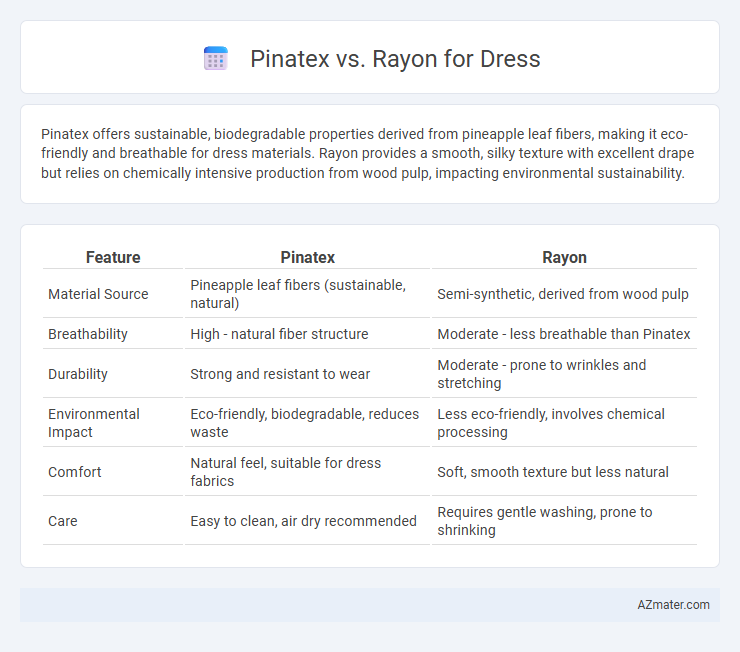Pinatex offers sustainable, biodegradable properties derived from pineapple leaf fibers, making it eco-friendly and breathable for dress materials. Rayon provides a smooth, silky texture with excellent drape but relies on chemically intensive production from wood pulp, impacting environmental sustainability.
Table of Comparison
| Feature | Pinatex | Rayon |
|---|---|---|
| Material Source | Pineapple leaf fibers (sustainable, natural) | Semi-synthetic, derived from wood pulp |
| Breathability | High - natural fiber structure | Moderate - less breathable than Pinatex |
| Durability | Strong and resistant to wear | Moderate - prone to wrinkles and stretching |
| Environmental Impact | Eco-friendly, biodegradable, reduces waste | Less eco-friendly, involves chemical processing |
| Comfort | Natural feel, suitable for dress fabrics | Soft, smooth texture but less natural |
| Care | Easy to clean, air dry recommended | Requires gentle washing, prone to shrinking |
Overview of Piñatex and Rayon
Pinatex is a sustainable, innovative material made from pineapple leaf fibers, offering a cruelty-free alternative to leather with durability and breathability ideal for dress fabrics. Rayon, a semi-synthetic fiber derived from cellulose, provides a smooth, silky texture and excellent drape, commonly used in apparel for its versatility and affordability. Both materials cater to eco-conscious fashion, with Pinatex emphasizing natural fiber reuse and Rayon focusing on cellulose regeneration through chemical processes.
Origins and Production Processes
Pinatex is derived from pineapple leaf fibers, a sustainable byproduct collected from pineapple plantations primarily in the Philippines, using a low-impact extraction method that minimizes waste and chemical use. Rayon, a semi-synthetic fabric, is produced from cellulose extracted from wood pulp, typically from trees like beech, pine, or bamboo, undergoing intensive chemical treatments including bleaching and dissolving with toxic solvents. The production of Pinatex emphasizes renewable agricultural waste and eco-friendly processing, while rayon's manufacturing can involve environmentally harmful chemicals and deforestation concerns.
Sustainability and Environmental Impact
Pinatex, made from pineapple leaf fibers, offers a sustainable alternative to rayon by utilizing agricultural waste and requiring less water and chemicals in production. Rayon, derived from cellulose and produced through chemically intensive processes, often contributes to significant deforestation and pollution. Choosing Pinatex over rayon can reduce environmental impact by supporting resource-efficient manufacturing and minimizing harmful emissions.
Texture and Aesthetic Comparison
Pinatex offers a natural, slightly coarse texture derived from pineapple leaf fibers, providing a distinct, eco-friendly, and earthy aesthetic ideal for sustainable fashion. Rayon, made from regenerated cellulose, typically features a smooth, silky finish with a fluid drape, lending dresses a luxurious and polished appearance. The choice between Pinatex and Rayon depends on desired tactile experience and visual style, with Pinatex emphasizing sustainability and texture, while Rayon prioritizes softness and elegance.
Comfort and Wearability
Pinatex offers a breathable and lightweight texture derived from pineapple leaf fibers, making it comfortable for prolonged wear in dresses. Rayon, known for its smooth and soft feel, provides excellent drape and moisture absorption, enhancing comfort in various climates. The natural fiber blend in Pinatex contributes to durability and wearability, while rayon's synthetic origins may result in less breathability but superior flexibility and ease of movement.
Durability in Dress Applications
Pinatex offers superior durability in dress applications due to its strong pineapple leaf fibers, providing resistance to wear and tear compared to the softer, less resilient structure of rayon. Rayon tends to lose strength when wet and is prone to pilling and deformation over time, making it less suitable for high-wear dress environments. Pinatex's natural fiber composition ensures longevity and maintains structural integrity, making it a preferable sustainable alternative for durable dress fabrics.
Ease of Care and Maintenance
Pinatex, made from pineapple leaf fibers, offers breathability and natural moisture resistance, making it easy to clean with mild soap and water and requiring minimal maintenance to retain its texture and color. Rayon, a semi-synthetic fiber derived from cellulose, tends to wrinkle easily and often requires dry cleaning or gentle hand washing to prevent shrinkage and maintain its smooth finish. Pinatex's durability and resistance to stains provide a low-maintenance alternative to Rayon, especially for everyday dress wear.
Cost and Market Availability
Pinatex, made from pineapple leaf fibers, generally costs more than rayon due to its sustainable production process and lower industrial scale. Rayon, a semi-synthetic fabric derived primarily from wood pulp, is widely available and more affordable, making it a common choice for mass-produced dresses. Market trends show increasing demand for Pinatex in eco-conscious fashion, but rayon remains dominant in terms of cost-effectiveness and accessibility.
Popular Designers and Fashion Trends
Pinatex, a sustainable textile made from pineapple leaf fibers, is favored by popular designers like Stella McCartney and Hugo Boss for eco-friendly dress collections, reflecting a growing trend towards plant-based materials in fashion. Rayon, a semi-synthetic fiber derived from cellulose, remains widely used due to its smooth texture and affordability, often seen in fast fashion brands and mainstream designers aiming for cost-effective versatility. Current fashion trends highlight Pinatex's rising appeal in luxury and sustainable segments, contrasting with Rayon's dominance in mass-market apparel, illustrating a shift towards environmentally conscious dress fabrics.
Choosing the Best Fabric for Dresses
Pinatex offers a sustainable alternative to traditional textiles with its breathable, durable, and eco-friendly pineapple leaf fibers, making it ideal for trendy, vegan dresses. Rayon, a semi-synthetic fabric derived from cellulose, provides a soft, smooth texture and excellent drape that enhances dress comfort and elegance. Choosing between Pinatex and Rayon depends on prioritizing sustainability and texture, where Pinatex stands out for eco-conscious fashion and Rayon excels in luxurious softness and fluidity.

Infographic: Piñatex vs Rayon for Dress
 azmater.com
azmater.com